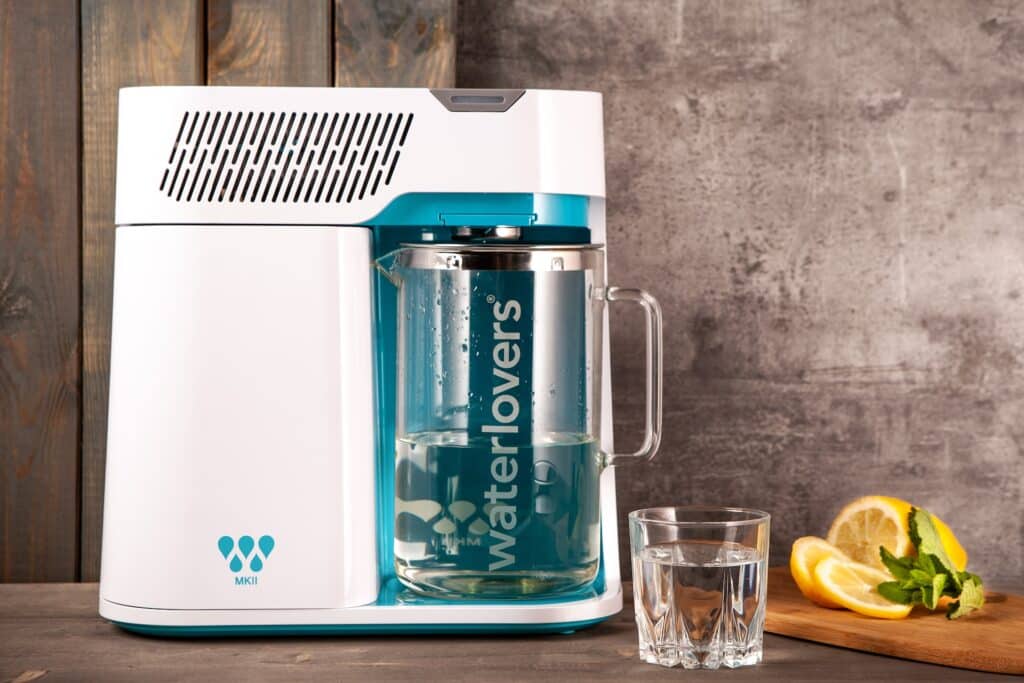PFAS chemicals, often called “forever chemicals”, are used in waterproof and nonstick products. These chemicals can end up in our drinking water and the environment, and they’re linked to serious health issues. It’s important to know about PFAS exposure and find ways to protect ourselves from these toxic substances.
What Are PFAS?
According to the Environmental Working Group (EWG), more than 200 million Americans could be drinking water contaminated with PFAS chemicals. So, what are PFAS?
Known as “forever chemicals,” PFAS are used to make water-resistant clothing and nonstick pots and pans. The problem is, they don’t break down very easily. Some studies, like those from the National Institute of Environmental Health Sciences, say that high levels of PFAS exposure can lead to serious health problems, including cancer.
Some specific PFAS, like perfluorooctanoic acid (PFOA) and perfluorooctane sulfonic acid (PFOS), are banned in the United States, but other PFAS chemicals are still used in the manufacturing process of everyday products.
Unfortunately, many people still don’t know about the risks of using products that contain these chemicals. That’s why we created this guide—to help families understand where PFAS are found and make smarter choices about which products they buy.
Commercial Products with PFAS
PFAS chemicals are often used to repel water and grease. That’s why you’ll find them in products like nonstick pans, pizza boxes, and microwave popcorn bags. They’re also used to make products water-resistant, so they’re also in workout clothes, rain jackets, and car seats.
Here is a list of products with PFAS chemicals:
- Beauty products
- Cleaning products
- Drinking water
- Fast food packaging
- Freshwater fish
- Firefighting foams
- Nonstick cookware
- Paints and sealants
- Water resistant fabrics
While some chemicals, like PFOS and PFOA, aren’t used as often in the products we buy, other PFAS chemicals are taking their place. These chemicals can contaminate the things we eat and drink. Additionally, when PFAS products are thrown away or used in manufacturing, they can pollute the drinking water, air, and soil around landfills and factories.

Beauty Products
Cosmetic products sometimes contain PFAS to enhance their water resistance and longevity. In 2021, a study from Environmental Science and Technology Letters analyzed 231 personal care products for the presence of fluorinated compounds. High PFAS levels, specifically in the form of fluorine, suggested that it’s highly likely these products contain toxic PFAS chemicals.
The study highlighted that foundations, concealers, lip products, and other facial items like blushes, bronzers, and powders had the highest fluorine content. Upon further examination of the products with the highest fluorine levels, every single one was found to contain at least four different toxic PFAS chemicals. The majority of these products did not list any PFAS substances on their ingredient labels.
Cleaning Products
One study from Environmental Pollution highlighted the fact that childcare centers, which undergo daily cleaning, typically had elevated PFAS levels—specifically fluorotelomer sulfonates. These PFAS compounds are often found in cleaning products and waxes. Given the nature of children’s activities, such as crawling and playing on the ground, there’s an obvious risk of PFAS exposure from these cleaning agents.
In order to reduce or eliminate PFAS contamination in your living environment, it’s recommended that you opt for cleaning products that feature the Green Seal certification. Noteworthy cities like Philadelphia, Los Angeles, and Chicago, in conjunction with states like Colorado and Pennsylvania, have partnered with Green Clean initiatives. Furthermore, educational institutions, like the University of Miami, and business entities, such as the World Bank, have also endorsed and implemented these environmental protection measures.
Drinking Water
PFAS are significant contributors to water contamination in the U.S. In 2019, the Environmental Working Group assessed PFAS levels in tap water across 31 states. Every location, save for one, showed signs of PFAS contamination. Of the affected locations, all but two had PFAS levels that could be associated with health risks.
Fast Food Packaging
Companies sometimes use PFAS substances to ensure that food packaging, especially those used for fast food, repels grease. These forever chemicals can transfer to the food, leading to PFAS exposure when consumed. Moreover, food items with high levels of fat or salt absorb more PFAS from the packaging, elevating the risk of PFAS contamination in many fast food options.
One effective approach to minimize PFAS exposure is by preparing more meals at home. One 2019 study showed that people who often ate meals from fast food establishments and other restaurants had elevated PFAS levels in their system, while those who predominantly consumed home-cooked meals had reduced levels of toxic PFAS chemicals.

Firefighting Foams
Those who live close to landfills, industrial sites, or firefighting training locations face an increased risk of PFAS exposure. When it comes to landfills, consumer products can release PFAS into the environment, contaminating both soil and water. Industrial site spills and emissions often result in PFAS pollution in neighboring areas. Moreover, firefighting foam, which contains PFAS substances to enhance its efficiency, can lead to PFAS contamination in nearby drinking water sources and wells.
In June 2023, 3M, a major manufacturer of firefighting foam, settled for $12.5 billion to address lawsuits pertaining to the contamination of water systems nationwide.
Firefighting foams use PFAS to improve their fire-suppression capabilities. However, when these toxic chemicals enter our ecosystems and groundwater, both human health and wildlife are vulnerable. To mitigate this environmental health risk, it’s recommended that people advocate for their local fire departments to switch to PFAS-free alternatives. California has been a notable frontrunner when it comes to initiating legislation to limit the use of PFAS in firefighting foams, but many states have yet to impose such restrictions.
Freshwater Fish
A study published in the journal Environmental Science highlighted that freshwater fish across the U.S. have high levels of PFAS contamination. On average, one serving of fish contained 48 parts per trillion of toxic PFAS chemicals. Consuming just one serving is equivalent to drinking a month’s worth of PFAS-contaminated water.
States like Michigan have proactively offered guidelines to help residents understand which fish sources and species have elevated PFAS levels. The guide, “Eat Safe Fish in Michigan,” suggests that people eat smaller fish, avoid bottom-feeders, and trim as much fat as possible during preparation. Cooking on a rack also helps drain PFAS-contaminated fat away from the fish.
Nonstick Cookware
Several nonstick pans use PFAS substances, which can lead to PFAS contamination in your food—especially if the pan is scratched or gets overheated. Opting for cookware without intentionally added PFAS, like cast iron skillets, stainless steel, or ceramic-coated pans, can reduce your risk of PFAS exposure.
Paints and Sealants
Paints and sealants frequently incorporate PFAS substances to enhance their spread and stain-resistance while minimizing issues like peeling and bubbling. While many paints have volatile organic compounds or PFAS, there are safer alternatives to avoid PFAS contamination. It’s recommended to look for products with a Green Seal verification or those labeled as free from both VOC and PFAS.
Water Resistant Fabrics
In 2022, a study by Toxic-Free Future examined outdoor apparel, bedding, tablecloths, and napkins from 10 popular retailers. The findings revealed that 72% of products promoted as stain- or water-resistant were contaminated with PFAS chemicals. On the other hand, items not advertised with these features were free from PFAS chemicals.
As the awareness of PFAS-related risks grows among companies, the availability of PFAS-free alternatives is on the rise. Notably, brands such as Deuter and Didriksons exclusively offer products without added PFAS, encompassing water-resistant backpacks and jackets.
How to Lower PFAS Exposure
Avoiding PFAS can be challenging, but being vigilant about reviewing product labels and staying up-to-date about the quality of your drinking water is essential to minimize your PFAS exposure.
Following the guidelines below can help reduce your exposure to these forever chemicals and minimize the associated health effects.
Test and Filter Water
For most people, drinking water is the most common source of PFAS. In order to determine the safety of your local water source, you’ll want to refer to the Environmental Working Group’s contamination map. The Environmental Protection Agency (EPA) recommends contacting your local water system for detailed reports about your water’s quality or using a state-certified laboratory for testing.
If you live in an area with PFAS contamination in the drinking water, consider investing in a high-quality water filter. The Minnesota Department of Health has stated that filters using activated carbon and reverse osmosis are efficient in eliminating PFAS substances from water.

Check Product Labels
PFAS exposure often comes from products like water resistant clothing, nonstick cookware, and personal care products. When shopping, steer clear of items with ingredients that have “perfluoro” or “fluoro” in their name. Always search for “PFAS-free” on product labels to make safer choices.
Follow Food Safety Guidelines
A 2019 study published in Environmental Health Perspectives identified that eating fast food, meals from restaurants, and microwave popcorn can lead to increased PFAS exposure.
To protect your health, opt for microwave popcorn bags labeled as “PFAS-free,” promptly move takeout food to your own dishes, or prepare meals at home using fresh ingredients. This approach not only reduces the risk of PFAS exposure, but also shields you from other toxic chemicals. For instance, foods tainted with glyphosate, a substance often present in weed killers, could pose additional health risks.
Buy PFAS Free Alternatives
Several brands are proactively making products without PFAS, especially for items that traditionally contain these toxic chemicals. By opting for PFAS-free consumer products, you’re signaling to companies the importance of prioritizing environmental health.
Environmental and Health Risks of PFAS Chemicals
PFAS not only pose threats to human health, but also severely affect our ecosystem—from wildlife to soil and air contamination. Research by EWG has identified the presence of PFAS in as many as 330 different animal species worldwide, with endangered species, like tigers and pandas, being no exception. These chemicals could have dangerous health implications for both animals and humans.
A 2022 publication in Frontiers in Toxicology studied PFAS concentrations in alligators living in the highly-polluted Cape Fear River in North Carolina. This river has been heavily contaminated by the neighboring Chemours chemical facility. In comparison to alligators from the less affected Lumber River basin, those from Cape Fear exhibited considerably elevated PFAS levels in their bloodstream.
Moreover, the alligators from Cape Fear displayed a 400-fold increase in the activity of interferon-alpha responsive genes, commonly associated with autoimmune disorders in humans.
Recent findings associate PFAS exposure with multiple health concerns, including:
- Cancer
- Elevated cholesterol levels
- Fertility issues
- Hormonal imbalances
- Liver damage
- Thyroid disorders
- Ulcerative colitis
Furthermore, the Cape Fear alligators exhibited a high incidence of unresolved or infected injuries, hinting at potential immune system disorders, demonstrating that PFAS chemicals jeopardize the health of both animals and humans.
Have You Been Exposed to PFAS?
PFAS, often dubbed “forever chemicals” due to their persistence in the environment, are produced on a massive scale and remain intact for millennia. As a result, it’s highly probable that you’ve encountered them. A 2012 CDC study revealed the presence of PFOA, PFOS, PFHxS, and PFNA in an overwhelming 97% of the American blood samples examined.
These compounds are everywhere, contaminating our water, air, and soil. Potential exposure can come from consuming produce grown in PFAS-affected soil, drinking tainted water, or inhaling polluted air.
People working at PFAS production sites face the highest contamination risk. A 1998 evaluation of these workers’ blood indicated PFOS concentrations at 941 micrograms per liter. In contrast, the average PFOS level for the broader U.S. population in 1999 stood at 30.4 micrograms per liter. This data implies that PFAS manufacturing employees had PFOS concentrations surpassing the general American population by a staggering 96%.
Military and PFAS
In 2022, research revealed that more than 116 military locations had drinking water with PFAS levels surpassing the EPA’s recommended threshold. This suggests that upwards of 600,000 military personnel might be at risk of exposure.
The prevalent use of firefighting foams at military installations is a primary source of this contamination, though external influences like industrial pollution also contribute. Individuals stationed at Camp Lejeune between 1953 and 1987, a site notorious for its toxic water contamination, might be eligible to pursue legal action for compensation.
Key Takeaways
PFAS are often called “forever chemicals” due to their longevity in the environment. They pose a wide range of health risks to humans and wildlife. Predominantly found in everyday products such as nonstick cookware, cosmetics, food packaging, and water-resistant clothing, their presence has contaminated drinking water, air, and soil.
The vast majority of Americans have been exposed to these chemicals, with certain groups, such as military personnel and workers in PFAS production sites, at an increased risk. The detrimental health effects linked to PFAS exposure range from cancer and thyroid disorders to fertility issues. While measures are being taken to curb the presence of PFAS in products and environments, it’s still vital for consumers to be vigilant by prioritizing PFAS-free alternatives and advocating for broader environmental protection measures to mitigate these risks. Awareness, information, and proactive measures are the first line of defense against the pervasive spread and impact of these chemicals.
References
- https://cdc.gov/exposurereport/data_tables.html
- https://ehp.niehs.nih.gov/doi/full/10.1289/EHP4092
- https://ewg.org/interactive-maps/pfas_contamination/map
- https://ewg.org/interactive-maps/pfas_in_wildlife/map/
- https://ewg.org/news-insights/news-release/2022/12/more-600000-service-members-given-forever-chemicals-drinking
- https://ewg.org/news-insights/news-release/study-more-200-million-americans-could-have-toxic-pfas-their-drinking
- https://ewg.org/research/national-pfas-testing
- https://frontiersin.org/articles/10.3389/ftox.2022.1010185/full
- https://health.state.mn.us/communities/environment/hazardous/topics/pfashometreat.html
- https://michigan.gov/mdhhs/-/media/Project/Websites/mdhhs/Safety-and-Injury-Prevention/Environmental-Health/Eat-Safe-Fish/Documents/family_fish.pdf
- https://ncbi.nlm.nih.gov/pmc/articles/PMC4483690/
- https://ncbi.nlm.nih.gov/pmc/articles/PMC7906952/
- https://ntp.niehs.nih.gov/ntp/ohat/pfoa_pfos/pfoa_pfosmonograph_508.pdf
- https://pubmed.ncbi.nlm.nih.gov/31901805/
- https://pubs.acs.org/doi/10.1021/acs.estlett.1c00240
- https://sciencedirect.com/science/article/pii/S0013935122024926?via%3Dihub#fig5
- https://toxicfreefuture.org/wp-content/uploads/2022/08/toxic-convenience.pdf
- https://www.mdpi.com/2304-8158/10/7/1443
